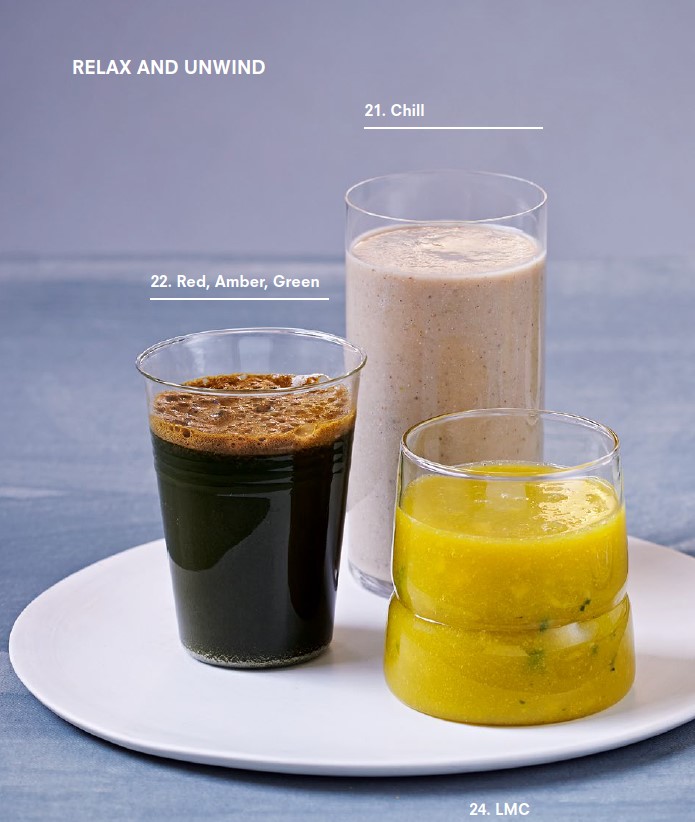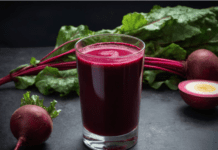
JUICES VERSUS SMOOTHIES
Juices and smoothies are similar in that they both use raw produce as the nutrient-dense drink base. The difference is that juices have the pulp removed, and smoothies don’t.
Juices are a great vehicle that I use to boost phytonutrients, which are
extremely easily absorbed by the body.
Smoothies are more substantial than juices and have a higher fiber content because
they use the whole fruit or vegetable.
Using a blender to make a smoothie also allows you to add in serious nutrient boosters such as seeds, avocados, flaxseed oil, and all sorts of supplemental powders.
Toss all the ingredients in the juicer and blend away—it’s so easy!
Breakfast is an essential meal, but people often struggle to find time to sit
down and eat properly.
A smoothie can be a great choice. Substantial and full of nutrition, it is a great start to the day. It is also instrumental during detox days if you are struggling with just juices.
Smoothies
Smoothies are a way to remain on liquids but have a little more sustenance to get you through the day. There have been considerations about the high sugar content in juices and smoothies.
This worry mostly comes from shop-bought drinks meant to be amazing but have actually been found to contain a high concentration of sweet fruits or added sugar or are made from concentrate or syrups.
This can provoke all sorts of problems, including weight gain, insulin intolerance, and, in serious cases, tooth decay.
This is true that certain fruits (and vegetables) possess a high natural sugar percentage, so I use lots of low-sugar ingredients, such as kale, celery, and cucumber, to counter this.
As your taste sensory buds get used to the flavors, you will be able to enjoy juices containing less sugar, opting for the more savory recipes and adding fewer sweet fruits to your own juice and smoothie concoctions.
I also use various fruits that have a high soluble fiber content. Soluble fiber does not get extracted during the juicing procedure, and it slows down the absorption of sugars in the bloodstream and therefore avoids a sugar spike.
You can always have a handful of seeds with your juice, as this slows absorption too.
Many of the juices aim to balance your blood sugar and help with any insulin intolerance issues.
A stable energy level is ideal, and that is what we hope to achieve.
Another problem with some store-bought smoothies and juices is that they are
also pasteurized, meaning they have been heated to eliminate bacteria.
Unfortunately, this also means that a lot of the goodness has been removed too. There are lots of juice bars popping up that sell good-quality, cold-pressed juices, but homemade are
cheaper, and you can be sure of where the produce came from.
ORGANIC & SEASONAL
I always use organic, if I can, to avoid pesticides. It means that there is no need to
peel the produce first (unless using something like a mango, avocado, or papaya); rinse, and you are ready to go.
Organic produce can be much more expensive and is not always available, so you might need a little more preparation if this is the case.
For non-organic ingredients, peel what can be peeled and give everything a thorough
wash because pesticides are persistent.
You’ll need to be ultra-careful in your washing, especially with leaves. Lettuce and spinach are among the most contaminated vegetables because they suck up pesticides from the soil and are sprayed the most to prevent the little bugs that love them.
Some ingredients are very seasonal, and if they aren’t in season but still on the supermarket shelves, then they may be expensive, and it will have to take a lot of air
miles to get them there.
This is when frozen foods are great. You can get all sorts of organic and non-organic fruits in the freezer section, picked and frozen right away, which preserves their nutrients.
Frozen berries or peaches are great in smoothies and juices, and you could also try frozen summer leaves like spinach and spring greens.
So you see, there is never an excuse not to eat a rainbow of fruits and vegetables every day!
PREPARATION
I tend not to core anything, but I do remove pits from any fruits that need it. Your
juicer and blender will not thank you for putting a plum pit through them.
If you use a juicer with a large chute, you shouldn’t need to cut anything up.
A little tip for juicing small leaves like rosemary is to wrap them in bigger leaves and pass them through the juicer that way.
For smoothies, I core and cube anything that requires it. Peel things like avocados, mangoes, and papaya, basically anything with tough skin.
As I have said, if it is organic, you can get away with not peeling, but I would advise
you to peel non-organic produce.
It is the quickest and easiest way to remove any pesticides that have been used.
For citrus fruits, I prefer to use a citrus press rather than put peeled citrus fruits
through the juicer. You can also squeeze the fruit by hand.
EQUIPMENT YOU’LL NEED
For juices, Centrifugal and masticating juicers are easily available on the market,
but for this article, I used a centrifugal juicer simply because they are
more common.
A centrifugal juicer uses a cylindrical grater to spin the juice from the incoming pieces of fruit or vegetables before discarding the pulp. It is fast and super-easy to use.
A masticating juicer, on the other hand, creates “cold-pressed” juices by crushing the fruit or vegetables and wringing the juice from the produce.
The reason it is COLD pressed is that there is no heat involved, meaning it is raw and the
nutrients haven’t been damaged by heating.
This applies to centrifugal juicing too. You will use smaller quantities of ingredients with a masticating juicer, and it is also an awesome machine when it comes to juicing green leaves. Because it’s so efficient, juiced greens will taste stronger.
I also prefer juicers with a chute large enough for the produce to be put in whole. There’s no point chopping fruit and vegetables when the juicer can do it for you.
For smoothies
I LOVE my NutriBullet because it is so compact that making a smoothie with it is fast and straightforward. It’s amazing and has such a powerful motor that you can blend everything, skin and all, to a smooth, liquid consistency.
It is a drinks blender, so it’s also smaller than a normal blender, making it good for storage
if you don’t have much room.
Of course, you can use a normal blender or a hand blender to make smoothies if
you have these already. Hand blenders may not cope with raw root vegetables and
nuts such as beets and almonds, so go gently and see what you can get away with.
If you invest in a blender, make sure that it has a good motor because
you don’t want to find it burns out the minute you challenge it with a harder piece of
fruit or vegetable.
Do a bit of research when you are buying new equipment. For both juicers and
smoothies, it is generally better to get one with a higher wattage.
This makes a difference in which vegetables and fruits the juicer can cope with. Ideally, you do want to be able to juice things like beets and sweet potato easily.
Final Word
However, you make your juice or smoothie, whether it is with a blender or a centrifugal
or masticating juicer, you will be making a lovely fruit and vegetable drink and
getting all the benefits of their vitamins and minerals.
Now go juice and feel well!








